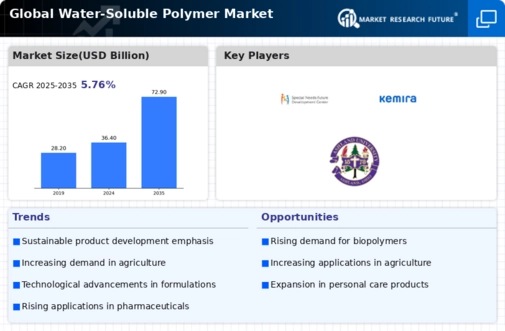Top Industry Leaders in the Water Soluble Polymer Market
 The water-soluble polymer market, is a dynamic and competitive space. With applications spanning diverse industries like water treatment, oil & gas, textiles, and agriculture, it's no surprise that a multitude of players vie for dominance. Let's delve into the strategies adopted, factors influencing market share, and recent developments that paint a picture of this ever-evolving landscape.
The water-soluble polymer market, is a dynamic and competitive space. With applications spanning diverse industries like water treatment, oil & gas, textiles, and agriculture, it's no surprise that a multitude of players vie for dominance. Let's delve into the strategies adopted, factors influencing market share, and recent developments that paint a picture of this ever-evolving landscape.
Strategies Shaping the Game:
-
Product Diversification: Leading players like BASF, Dow, and Ashland are constantly expanding their portfolios, offering customized water-soluble polymers for specific applications. This caters to diverse customer needs and strengthens brand loyalty. -
Sustainability Push: Environmental concerns are driving the development of eco-friendly polymers. Companies like Kemira are introducing bio-based and biodegradable options, appealing to environmentally conscious consumers. -
Technological Advancements: Investments in research and development are leading to the creation of high-performance polymers with enhanced properties. This ongoing innovation keeps competitors on their toes. -
Strategic Acquisitions: Mergers and acquisitions are a common tactic for market expansion. Dow's acquisition of Rohm and Haas in 2009 solidified its position as a major player. -
Regional Focus: Emerging economies like China and India offer immense growth potential. Companies are tailoring their strategies to cater to these markets, setting up production facilities and establishing local partnerships.
Factors Determining Market Share:
-
Product Portfolio Breadth: Companies with a wider range of polymers catering to diverse applications hold an advantage. -
Brand Reputation and Trust: Established players with a proven track record of quality and reliability command greater customer loyalty. -
Innovation and Technological Expertise: The ability to develop new, high-performance polymers opens up new market segments and strengthens competitive edge. -
Cost Competitiveness: Efficient manufacturing processes and strong supply chain management are crucial for maintaining profitability and market share. -
Geographical Presence and Distribution Network: A robust global presence and efficient distribution channels enable companies to reach a wider customer base.
Key Players
- SNF Group (France)
- Kemira (Finland)
- BASF SE (Germany)
- Ashland (US)
- KURARAY CO., LTD. (Japan)
- DuPont (US)
- Arkema S.A. (France)
- The Dow Chemical Company (US)
- Nitta Gelatin, NA Inc. (US)
- Gantrade Corporation (US)
- Akzo Nobel N.V. (Netherlands)
- Sumitomo Seika Chemicals Co., Ltd. (Japan)
- CP Kelco U.S. (US)
- Shandong polymers Bio-chemicals Co. Ltd. (China)
- Mitsubishi Chemical Corporation (Japan)
Recent News
February 2022: Kemira Oyj has announced that it is starting full-scale production of a polyacrylamide polymer based on biobased feedstock. The first commercial volumes are shipped to one of Helsinki Region Environmental Services (HSY) wastewater treatment plants for trials.
In Mar 2022, Kemira began producing a novel polymer at full capacity with the use of biobased feedstock. One of the wastewater treatment facilities run by Helsinki Region Environmental Services (HSY) got its hands on some commercial quantities for testing purposes.
As a functionally equivalent alternative to this specific polymer type, Kemira provides biomass-balanced polyacrylamide, which is water-soluble so that it can be dissolved easily in water or other suitable solvents such as alcohols or glycols which are commonly used as solvents in many applications where polymers find use today including those related to energy storage systems like batteries; these various industries have great need for them due largely because apart from being cheap they also work efficiently without producing any harmful emissions into our environment during their operation phase(s).
Ashland Global Holdings Inc.: Ashland introduced the Aquaflow™ NX Series of hydroxyethylcellulose (HEC) polymers in 2021. Coatings, construction, personal care and oil and gas are some applications for these polymers. The series includes products with different viscosity levels and compatibility with other materials.

